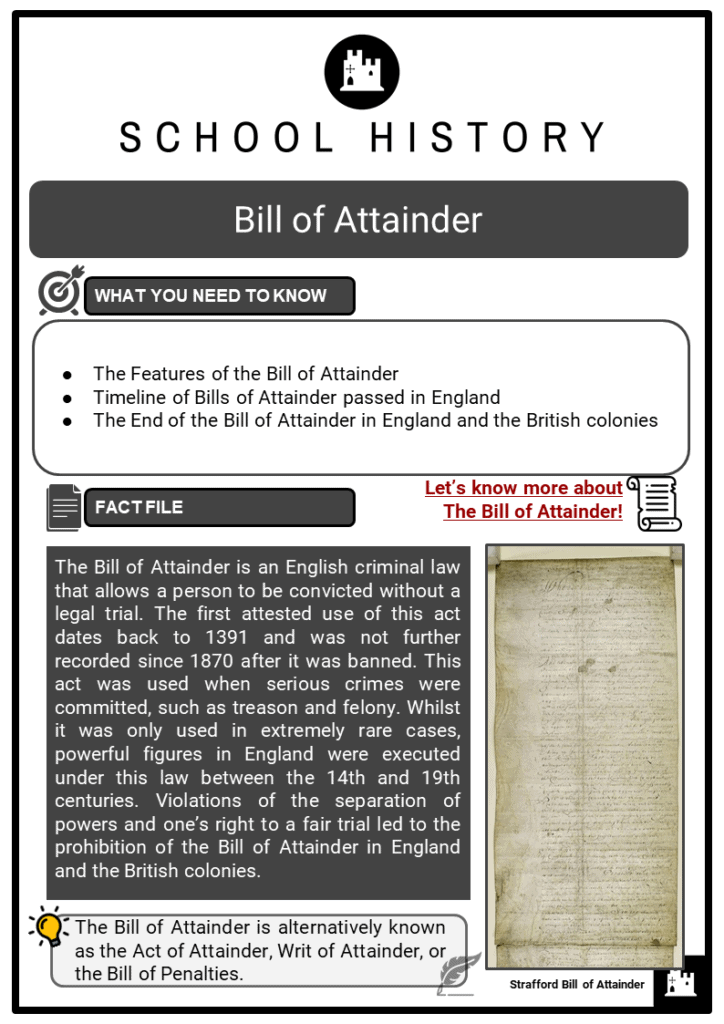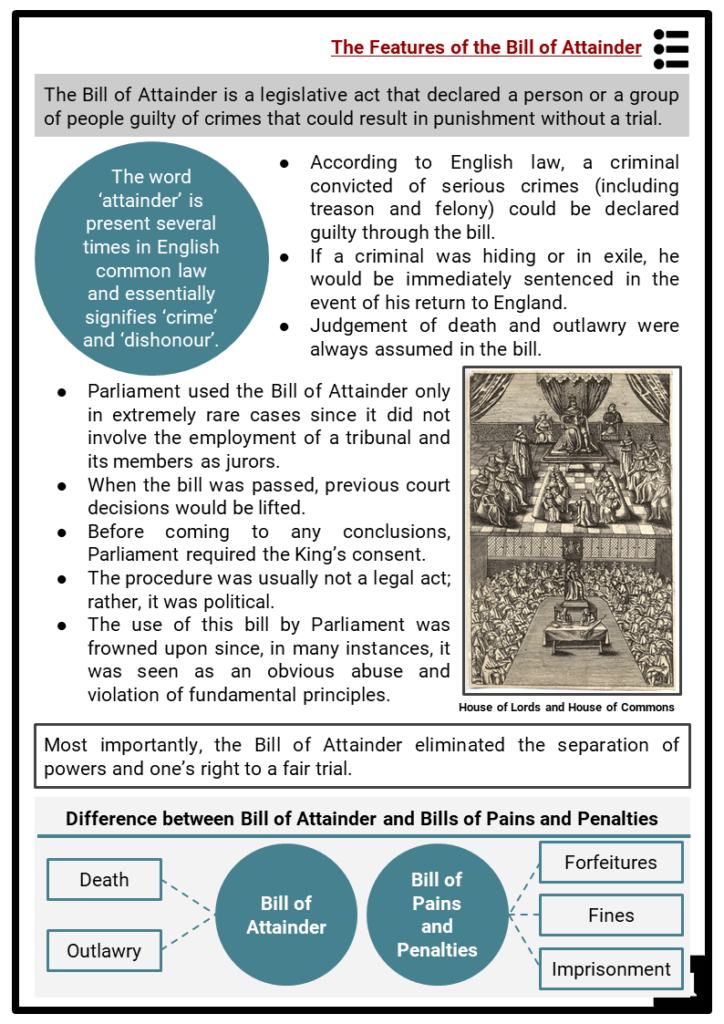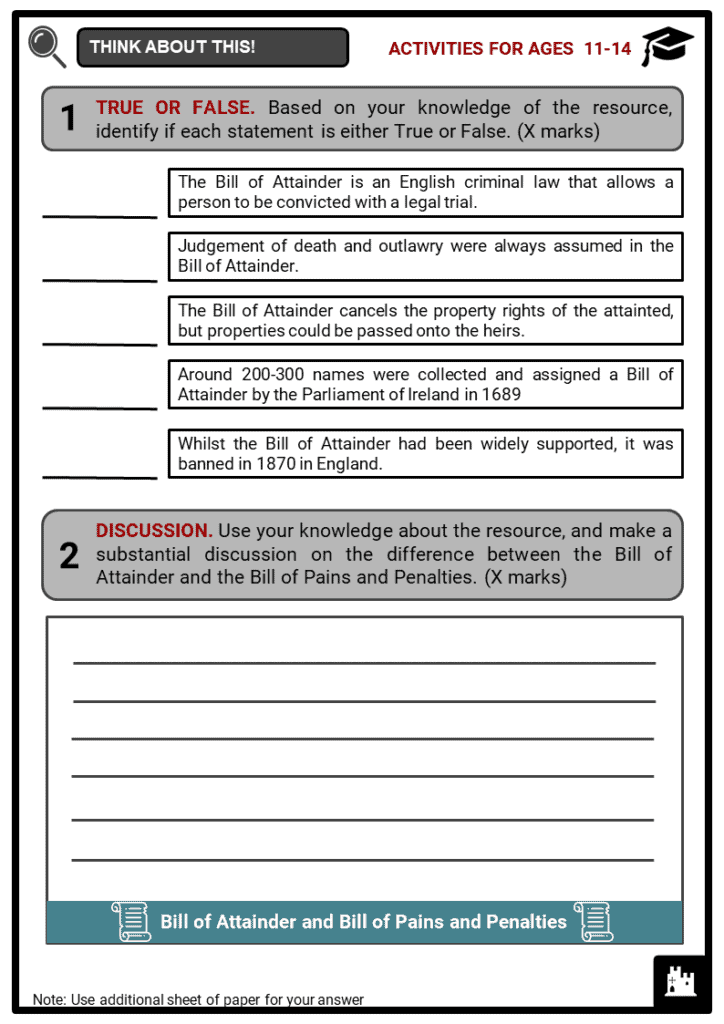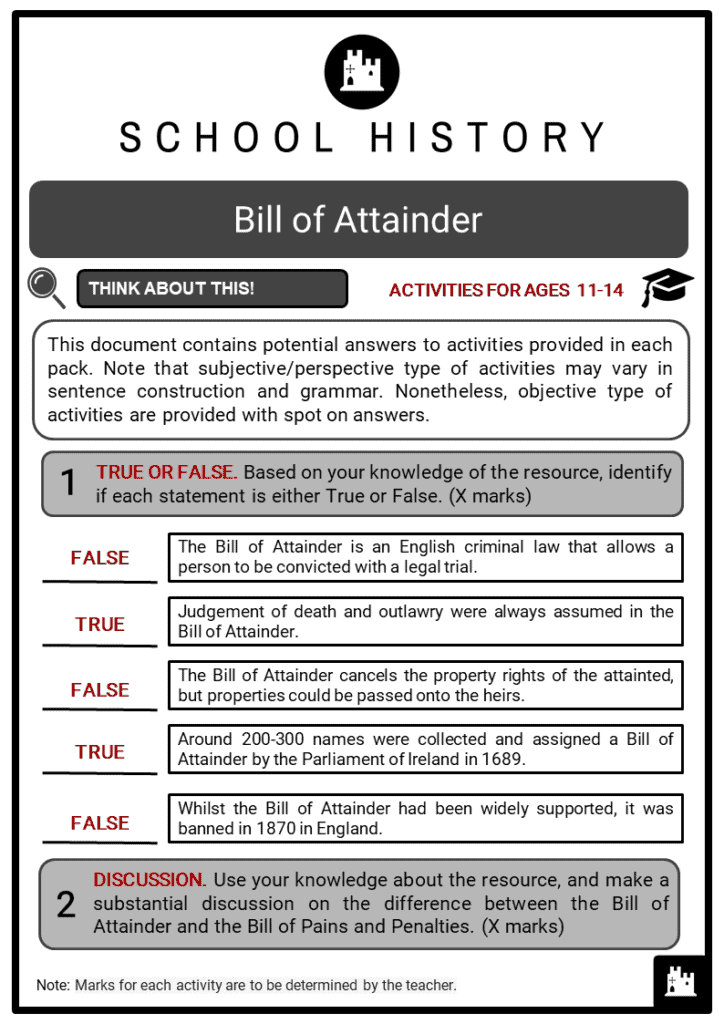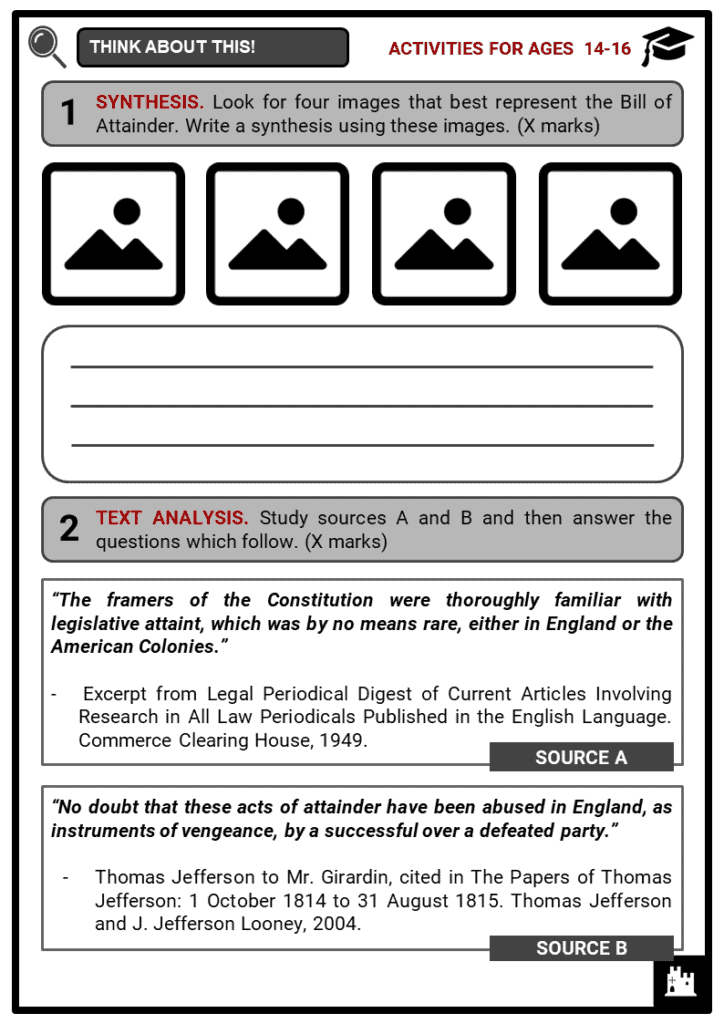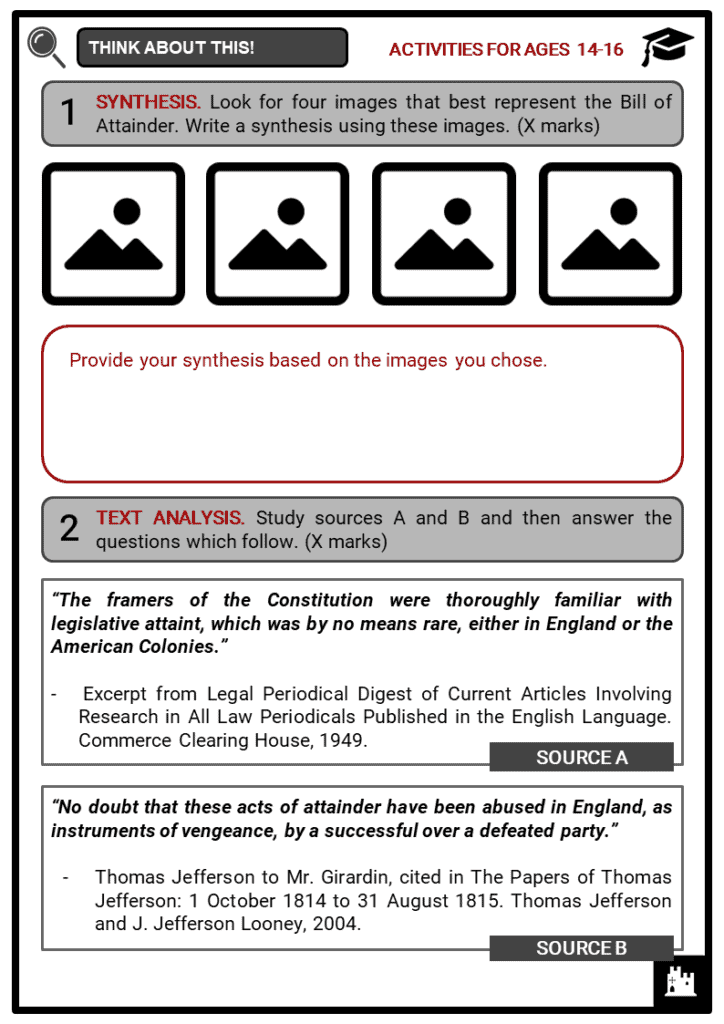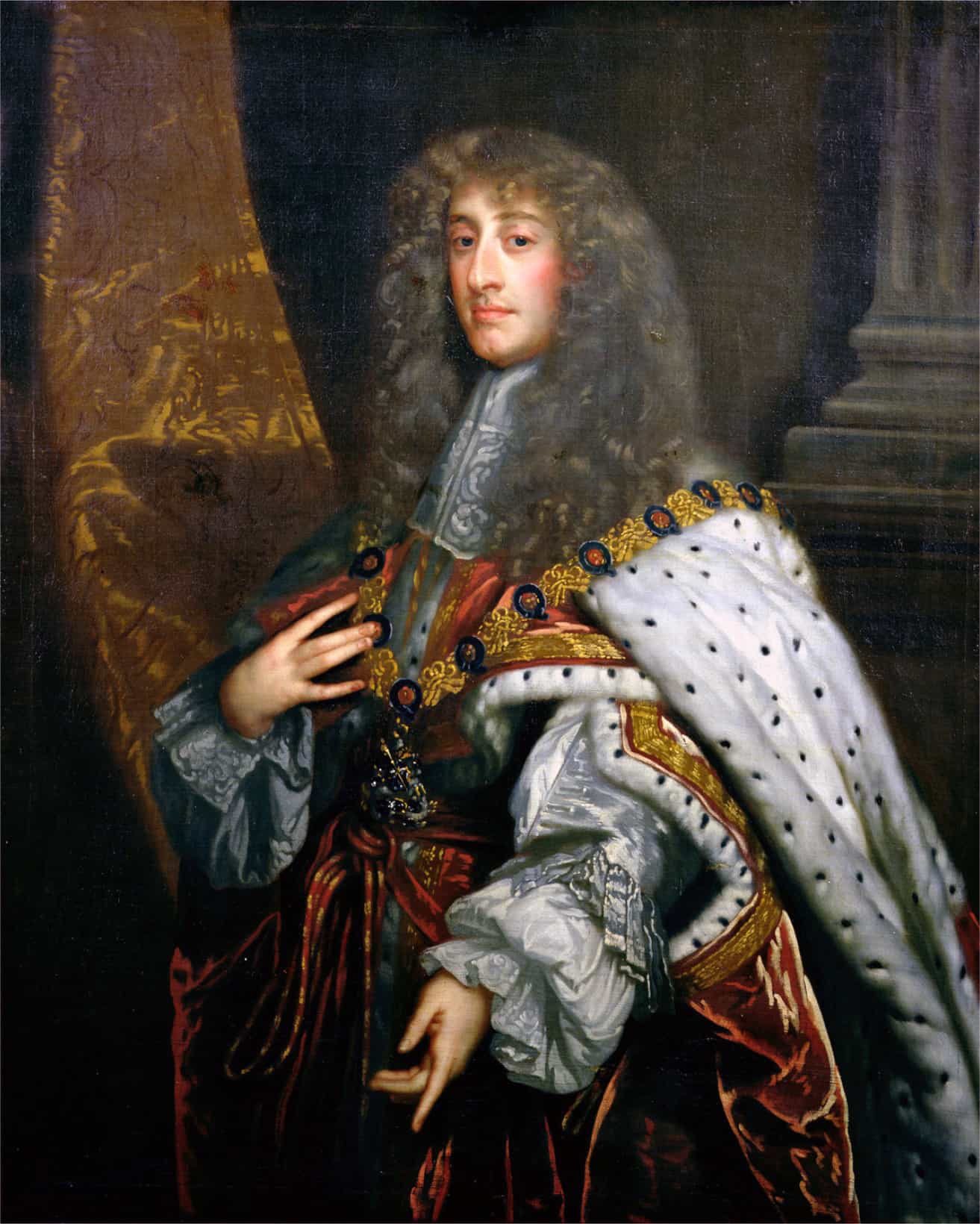Download Bill of Attainder Worksheets
Do you want to save dozens of hours in time? Get your evenings and weekends back? Be able to teach Bill of Attainder to your students?
Our worksheet bundle includes a fact file and printable worksheets and student activities. Perfect for both the classroom and homeschooling!
Table of Contents
Add a header to begin generating the table of contents
Summary
- The Features of the Bill of Attainder
- Timeline of Bills of Attainder passed in England
- The End of the Bill of Attainder in England and the British colonies
Key Facts And Information
Let’s know more about The Bill of Attainder!
- The Bill of Attainder is an English criminal law that allows a person to be convicted without a legal trial. The first attested use of this act dates back to 1391 and was not further recorded since 1870 after it was banned. This act was used when serious crimes were committed, such as treason and felony. Whilst it was only used in extremely rare cases, powerful figures in England were executed under this law between the 14th and 19th centuries. Violations of the separation of powers and one’s right to a fair trial led to the prohibition of the Bill of Attainder in England and the British colonies.
- The Bill of Attainder is alternatively known as the Act of Attainder, Writ of Attainder, or the Bill of Penalties.
The Features of the Bill of Attainder
- The Bill of Attainder is a legislative act that declared a person or a group of people guilty of crimes that could result in punishment without a trial.
- According to English law, a criminal convicted of serious crimes (including treason and felony) could be declared guilty through the bill.
- If a criminal was hiding or in exile, he would be immediately sentenced in the event of his return to England.
- Judgement of death and outlawry were always assumed in the bill.
- The word ‘attainder’ is present several times in English common law and essentially signifies ‘crime’ and ‘dishonour’.
- Parliament used the Bill of Attainder only in extremely rare cases since it did not involve the employment of a tribunal and its members as jurors.
- When the bill was passed, previous court decisions would be lifted.
- Before coming to any conclusions, Parliament required the King’s consent.
- The procedure was usually not a legal act; rather, it was political.
- The use of this bill by Parliament was frowned upon since, in many instances, it was seen as an obvious abuse and violation of fundamental principles.
- Most importantly, the Bill of Attainder eliminated the separation of powers and one’s right to a fair trial.
- The bill was often criticised as it was sometimes used by rulers to punish those who had disappointed them on a personal level rather than through any legal standing.
- It was also used with the intention of confiscating property of influential individuals to whom the bill was assigned.
- Characteristics which distinguished bills of attainder from all other penal statutes:
- They always inflict the penalty of death upon the offender, or of outlawry, which is equivalent to death.
- They are always ex post facto laws, being passed after the crime was committed.
- They never allow the guilt or innocence of the persons attainted to be ascertained by trial; but the guilt is attributed to them by act of Parliament.
- They always inflict certain penalties, among which were corruption of blood and forfeiture of estate. The essence of attainder was in corruption of blood, and without the corruption of blood no person was by the English law attainted.
- Corruption of blood meant the impurity that results from attainder and disqualifies the attainted person from inheriting, retaining, or bequeathing lands and property.
Timeline of Bills of Attainder passed in England
- The act was utilised in England between the 14th century and the 19th century in order to eliminate a large number of powerful historical figures.
- 1321 - Hugh le Despenser the Elder, 1st Earl of Winchester, and his son Hugh Despenser the Younger, Earl of Gloucester were dishonoured for supporting Edward II during his disagreements with the Queen.
- 1478 - George Plantagenet, 1st Duke of Clarence was convicted of treason against his brother, Edward IV.
Tudor Period
- 1485 - Henry VII used parliament to take action against his predecessor after defeating Richard III and replacing him on the throne of England.
- In essence, anyone who had fought for Richard against him would be guilty of treason and their lands and properties could be legally confiscated.
- Thomas Cromwell, who arranged the marriage of Henry VIII and Anne of Cleves was later convicted of treason and heresy.
- 1540 - Margaret Pole, Countess of Salisbury was allegedly involved in the Exeter conspiracy.
- A tunic with the Five Wounds of Christ was used against her, and she was accused of supporting Catholicism and the rule of her son Reginald and the King's Catholic daughter Mary.
- 1542 - Katherine Howard was convicted of treason for committing adultery with her distant cousin, Thomas Culpeper.
- King Henry VIII was the first monarch to delegate the execution to Parliament in order to avoid being the instigator of his wife’s death.
- 1549 - Thomas Seymour, 1st Baron Seymour of Sudeley was convicted with thirty-three charges of treason.
- 1572 - Thomas Howard, 4th Duke of Norfolk was executed for his role in the Ridolfi Plot, in which he planned to marry Mary, Queen of Scots if she would ascend the throne.
Stuart Period
- 1641 - Thomas Wentworth, 1st Earl of Strafford was condemned to death by Parliament after failure of impeachment.
- He was the principal advisor to King Charles I of England.
- 1645 - William Laud, Archbishop of Canterbury, who was a key advocate of Charles I’s religious reforms, was arrested by Parliament in 1640 and charged with treason.
- 1685 - James Scott, Duke of Monmouth went to West England and started a rebellion to overthrow his uncle, James II.
- He was defeated, charged with treason, and beheaded.
- 1660 - Whilst dead at the time of the restoration, the following Parliamentarians behind the regicides of Charles I in 1649 were instigated through the Bill of Attainder when both houses of parliament approved the bill in 1660.
- John Bradshaw, President of the High Court of Justice
- Oliver Cromwell, Parliamentarian army leader
- Henry Ireton, Parliamentarian army general
- Thomas Pride, Parliamentarian army commander
The Great Act of Attainder
- 1689 - In 1688, the English King James II (James VII of Scotland), dethroned by William III and Mary Stuart during the Glorious Revolution, went to Ireland with the sole purpose of reclaiming his throne.
- After his arrival, the Parliament of Ireland collected the names of people that had turned against the King in 1689.
- Around 200-300 names were collected and assigned a Bill of Attainder.
- Those on the list were taken to Dublin in order to be sentenced.
- Lord Mountjoy who was imprisoned in the Bastille in France received the news about an Attainder being issued for him.
- Mountjoy was advised to escape from his cell to return to Ireland for punishment as he would have faced a worse death in France.
- Many rebelled against the King’s abuse of power since he was believed to have no right to impose such a bill.
- 1753 - Archibald Cameron of Lochiel, a Jacobite leader was condemned to death on the basis of a seven-year-old bill of attainder, instead of being put on trial for his recent subversive activities in Scotland.
- 1798 - Lord Edward Fitzgerald was arrested for leading the Irish Rebellion.
- He died from wounds he received whilst resisting arrest
Private Bill
- 1820 - In the United Kingdom, the House of Lords passed a Pains and Penalties Bill that sought to divorce Queen Caroline from King George IV and adjust her titles and property accordingly.
- The House of Commons rejected the private bill.
- Private bill involves the private interests of a particular individual, corporation, or local unit.
World War II
- 1942 - On January 1, 2006, with the opening of the secret British archives relating to WWII, it was discovered that in early December 1942, Prime Minister Winston Churchill had devised a system to execute Nazi leaders who were prisoners of the English.
- In order to circumvent any legal obstacles, Churchill found his solution in the use of the ancient Bill of Attainder.
- However, he was discouraged by politician Richard Law, who pointed out that the United States and the Soviet Union (the most powerful allies of England) continued to declare themselves in favour of legal processes.
The End of Bill of Attainder in England and British colonies
- The Bill of Attainder had been widely criticised in England and British colonies.
- During the 18th century, the use of bills of attainder spread to the British colonies.
- Angered with the injustice of the attainder, some colonists were motivated to revolt.
- In 1779, a bill of attainder was passed in at least one American state (New York) to seize the property of British loyalists (called Tories) as both a penalty for their political sympathies and as a means of funding the rebellion.
- The last attested use of the bill in England was in 1798 and it was finally banned in 1870.
- Tories were generally monarchists, who believed in traditionalism and conservatism and opposed liberalism.
- Finally in 1789, the British attainder laws were prohibited in the United States as they were a clear violation of the separation of powers.
- Every state had forbidden the act in their constitution.
Image sources:
[1.] https://upload.wikimedia.org/wikipedia/commons/9/99/James_II_by_Peter_Lely.jpg
[2.] https://upload.wikimedia.org/wikipedia/commons/b/bc/Sir_Winston_Churchill_-_19086236948.jpg

